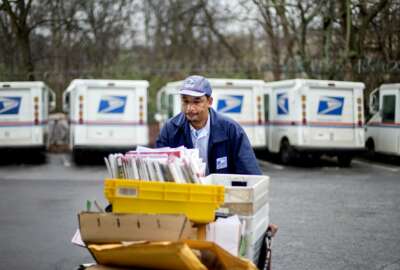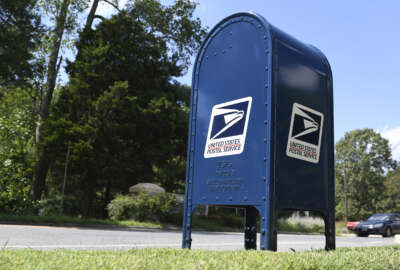The Postal Service has changed more than you think in the last 20 years
As one of the oldest federal services, the Postal Service has changed constantly over the centuries. In fact, a lot has happened just in the 21st century. The USPS...
As one of the oldest federal services, the Postal Service has changed constantly over the centuries. In fact, a lot has happened just in the 21st century. The USPS Office of Inspector General (OIG) has created an online history, starting with the anthrax mailings shortly after 9/11. For details, the Federal Drive with Tom Temin talks with the Research Manager at the OIG’s Research Insights Solutions Center, John Althen.
Interview Transcript:
Tom Temin And why did you do this in the first place? What was the purpose in the OIG of all places, creating kind of a timeline of the Latter day Postal Service?
John Althen Yeah, well, I work with a small research team here at the USPS Office of Inspector General that writes white papers, usually around 20 pages, and they look into broad issues impacting the Postal Service, things like national economic trends or public policy discussions around the Postal Service. And in the case of this paper, we looked at the history of the USPS in the 21st century. But we recognize that people are busy and not everyone is a complete postal nerd with time to read a long research paper. But at the same time, people are interested in the Postal Service. So we’ve been looking for ways to make our research more engaging for stakeholders. And something recently released for a paper on the history of the USPS was a digital story, sort of giving people an interactive experience. It’s much shorter than a white paper, but it pairs sort of the key highlights with relevant pictures and movement on the screen to sort of give the reader a journey through the research year by year of the 21st century, and hopefully folks find it a more engaging way to engage with our research.
Tom Temin Now was the beginning of the 21st Century an arbitrary standpoint? I mean, what is significant about these last 22, 23 years? Lord knows a lot’s happened for sure.
John Althen So starting around 2000, the Postal Service really started to experience some of the challenges that would create financial challenges for up to today. So the obvious one that your listeners would probably be aware of is digital diversion. The diversion about traditional ways of correspondence or advertising onto a digital platform. But also there were some other key events. There was postal reform in 2006 that set up some financial obligations and liabilities from the Postal Service that had a long term impact as well as the Great Recession. So there’s a lot of things in that first decade of the 21st century that we’re still feeling today and we’re still talking about today.
Tom Temin Yes. So that reform caused them to be forced to prefund retirement benefits. And so that took a lot of money out of a current year’s cash flow and made it financially difficult for the postal service. That eventually got changed. But it took a long time.
John Althen Yeah, it didn’t change until 2022. And that occurred right around 2007, same time of the Great Recession. So you see right after that, in 2009, for instance, there’s a 25 billion piece fall in mail volume, which is the largest annual drop. So the Postal Service has been dealing with that since, trying to find ways to mitigate those challenges.
Tom Temin Right. The peak, the story says, of mail volume was in 2006. I didn’t realize it was that late.
John Althen Yeah. And even up till then, despite the rise of the Internet early in that period, advertising mail volumes were still growing until then. So there was still some hope on the horizon.
Tom Temin So people stop sending letters and putting stamps on them and sending to people that the classic first class, then the advertising direct mail kind of fell down. So what is the status of mail volume now? What does the story say about that?
John Althen Well, first class mail volume is still declining. Advertising mail has been more resilient over the years in the United States. But, you know, recently it had some challenges as well. But at the same time, as you know, e-commerce has risen. So, Postal Service’s package business has increased as well. So there’s really been a shift in the mail mix over the last couple of decades.
Tom Temin Yes. One of the things the story highlights is the landmark signature with the air carrier services to combine with Postal Service. And that’s kind of the Amazon era approach, I guess you might say.
John Althen Yeah. Early on in the 21st century, they made some deals with air carriers. And then also related to e-commerce, the not so much related to the air carriers, but they started doing last mile delivery partnerships with folks like Amazon as well as Sunday delivery. So they made some innovations there to try to accommodate e-commerce.
Tom Temin We’re speaking with John Althen. He’s the research manager for the Research Insights Solutions Center at the USPS Office of Inspector General. And there were some pretty calamitous events, as I remember, right after 911. In the aftermath, it seemed connected at the time that these anthrax mailings went to Capitol Hill and so on. And how did that affect USPS besides in the immediate tracing of where those came from?
John Althen Yeah. So the anthrax mailings, I mean, it was not only a threat to postal employees, a couple of postal employees tragically died because of the anthrax mailings, but it also created an operational challenge, you know, that really kicked in new processes and equipment that the Postal Service had to think about and invest in to mitigate terrorist threats, not just of anthrax, but you’ve seen pipe bombs in recent decades that have been sent through the mail. And the Postal Service has had to sort of adapt with this new national security threat.
Tom Temin By the way, how many Postmasters General, have there been in this century?
John Althen There’s been four PMGs in the 21st century, and it’s technically five. One went up to 2001. So technically 5 PMGs in the 21st century, and most recently it’s Louis DeJoy.
Tom Temin And he’s the first kind of outsider in a long time. Most of them have come up through the ranks.
John Althen Yeah, I think in 40 years or so, there’s been mostly postmasters that have come up through the ranks and Louis DeJoy is the first that really came from outside the organization. And so it’s shaking things up a bit as far as his approaches, his outlook.
Tom Temin Sure. And so given this history that you’ve created, this visual history, who do you think should read it? I mean, who is it intended for?
John Althen Yeah. So our primary stakeholders that we send our work to are Postal Service management, the Board of Governors and Congress. But because our research group often looks at these broad issues, we have a variety of stakeholders, industry stakeholders, mailers, the labor unions and other are the folks that work in the industry, but also with a paper like this that looks at through the history of the 21st century, you know, I think it could be of interest to the general public because its ultimately who the Postal Service serves and they obviously have a great interest in the evolution of the Postal Service.
Tom Temin That’s interesting. The point you bring up about the Postal Service’s role in the history of the nation itself, You know, every so often people will release a trove of letters, you know, written during World War Two or something or some early era. Do you ever worry that because people don’t write letters anymore, that a lot of history could just not exist for the general public? You know, maybe you don’t release those letters till after the parties are deceased because of privacy, but there’s a piece of American history at the personal level that just won’t exist anymore because of the lack of letters.
John Althen Yeah, that is an interesting question. I mean, we’ve done research in the past showing that people still put sort of an emotional connection to letter writing itself. And I think you see that coming up in a few months here around the holidays and Christmas where people still send holiday cards and it means more. So I think there is some sort of stronger attachment with a physical medium, perhaps that might be an enduring sort of value of the mail stream going forward.
Tom Temin Yeah. All right. So from the OIG standpoint, you’ve made a millions of recommendations on so many fronts that affect postal operations. Where would the OIG like to see the Postal Service go in the next quarter century or next 20 years, let’s say?
John Althen Yeah, well, that’s out of scope for this paper.
Tom Temin Yeah, it’s above your pay grade here, right?
John Althen So I can’t speak to sort of the specifics on current strategic decisions, but I think of course, we’d all love to see sort of a healthy and thriving postal system. In the past, the OIG has talked a lot about technological innovation or trying new types of partnerships. So I think that’s something we’ve spoken to in the past as sort of a potential opportunity. And of course the OIG will continue working to maintain the integrity and accountability of the postal system.
Tom Temin Will you urge them to do a mailing to every household with the URL of this story so that people can see it for themselves.
John Althen If they want to get it out there? I wouldn’t discourage it.
Copyright © 2025 Federal News Network. All rights reserved. This website is not intended for users located within the European Economic Area.
Tom Temin is host of the Federal Drive and has been providing insight on federal technology and management issues for more than 30 years.
Follow @tteminWFED





